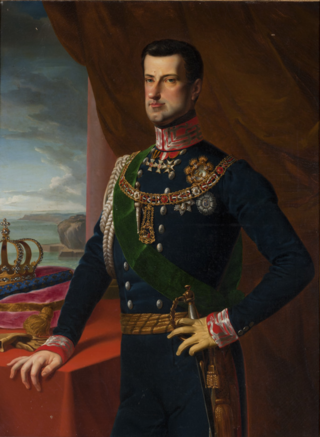Related Research Articles

Piedmont is a region of Northwest Italy, one of the 20 regions of the country. It borders the Liguria region to the south, the Lombardy and Emilia-Romagna regions to the east and the Aosta Valley region to the northwest; it also borders Switzerland to the northeast and France to the west. It has an area of 25,402 km2 (9,808 sq mi) making it the second largest region of Italy after Sicily and a population of 4,269,714 as of 31 January 2021. The capital of Piedmont is Turin.

Charles Felix was the Duke of Savoy, Piedmont, Aosta and King of Sardinia from 1821 to 1831.

Charles Albert was the King of Sardinia from 27 April 1831 until 23 March 1849. His name is bound up with the first Italian constitution, the Albertine Statute, and with the First Italian War of Independence (1848–1849).

Luigi Palma di Cesnola, an Italian-American soldier, diplomat and amateur archaeologist, was born in Rivarolo Canavese, near Turin. He received the Medal of Honor for his actions during the American Civil War. He was United States consul at Larnaca in Cyprus (1865–1877) and first Director of the Metropolitan Museum of Art in New York (1879–1904).

The Battle of Novara was one of the battles fought between the Austrian Empire and the Kingdom of Sardinia during the First Italian War of Independence, within the era of Italian unification. Lasting the whole day of 22 March 1849 and ending at dawn on 23 March, it resulted in a severe defeat and retreat of the Piedmontese (Sardinian) army.

Luigi, Count Cibrario was an Italian statesman and historian.

Novara is the capital city of the province of Novara in the Piedmont region in northwest Italy, to the west of Milan. With 101,916 inhabitants, it is the second most populous city in Piedmont after Turin. It is an important crossroads for commercial traffic along the routes from Milan to Turin and from Genoa to Switzerland. Novara lies between the rivers Agogna and Terdoppio in northeastern Piedmont, 50 kilometres (31 mi) from Milan and 95 kilometres (59 mi) from Turin.

The First Italian War of Independence, part of the Italian Unification (Risorgimento), was fought by the Kingdom of Sardinia (Piedmont) and Italian volunteers against the Austrian Empire and other conservative states from 23 March 1848 to 22 August 1849 in the Italian Peninsula.

Ettore Perrone, Conte di San Martino was an Italian politician and military leader.
Royal war and popular war is a recurring concept in the historiography of the Italian Risorgimento, referring to the two possible forms in which the whole of Italy could be conquered and formed into a single independent state.
Juste-Charles de Faÿ de la Tour-Maubourg (1774–1846) was a French aristocrat and fighter in the French Revolution.

Hugh of Noara or of Novara, also known as Ugo of Novara and Hugo of Novara, was a Cistercian monk and a disciple of Bernard of Clairvaux. French by birth, he served as the first abbot of Novara Abbey, Sicily, where he remained until his death in 1170.

The Royal Library of Turin is a library located within the ground floor of the Royal Palace of Turin, itself a World Heritage Site in Turin, Italy.

Duke of Galliera is an Italian noble title that has been created several times for members of different families. The name of the title refers to the comune of Galliera, which is located in the Province of Bologna in Emilia–Romagna.
The following is a timeline of the history of the city of Turin, Piedmont, Italy.

The Royal Armoury of Turin is one of the world's most important collections of arms and armour, formed in Turin by the Savoy family. The museum is now part of the Musei Reali di Torino, the royal site that has unified the Royal Palace, the Sabauda Gallery, the Archaeological Museum, the Royal Library and the Armoury. The whole site has been included on the UNESCO World Heritage list since 1997.

Alessandro Riberi was a surgeon, physician, academic and Italian politician. He was considered to be the most distinguished Italian physician of his time. He founded the Italian army medical corps.

The Regiment "Savoia Cavalleria" (3rd) is a cavalry unit of the Italian Army based in Grosseto in Tuscany. The regiment is the reconnaissance unit of the Paratroopers Brigade "Folgore".

The Regiment "Lancieri di Novara" (5th) is a cavalry unit of the Italian Army based in Codroipo in Friuli Venezia Giulia. The regiment is the reconnaissance unit of the 132nd Armored Brigade "Ariete".

Filiberto Avogadro di Collobiano was an Italian courtier and politician who was an advisor to King Charles Felix of Sardinia, who conferred on him the noble title of count, and a member of the royal court of King Charles Albert. He was a member of the Subalpine Senate for 20 years.
References
- This article originated as a translation from this version of its counterpart in the Italian Wikipedia .
- ↑ ‘Regesto’ Archived 2011-07-22 at the Wayback Machine , L’Armeria Reale di Torino.
- ↑ ‘Rotonda - Horses and bards - Catalogue S.58’ Archived 2011-07-22 at the Wayback Machine , Armeria Reali di Torino, Ministero per i Beni e le Attività Culturali.